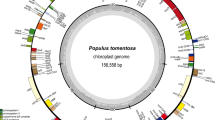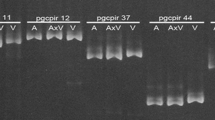Abstract.
The chloroplast DNA diversity of 33 accessions belonging to 16 species of five sections in Allium subgenus Rhizirideum was studied by analysing the sequence of three fragments: the trnL-F intergenic spacer, the rps 16 intron and rbcL (rubisco large subunit). The three sections Cepa, Schoenoprasum and Rhizirideum, representing the majority of the included species, each possess a separate clade after phylogenetic analysis. Exceptions to this general rule are the placement of Allium pskemense (section Cepa) connected to Allium senescens (section Rhizirideum) and Alium roylei, taking an intermediate position between sections Cepa and Schoenoprasum. Both species were located in their own section after nuclear DNA analysis. A range of crossing experiments has been carried out. The different position of A. roylei when comparing cpDNA and nDNA diversity was not confirmed with the production of hybrid seeds after crossing A. roylei with species other than those of section Cepa. The different position of A. pskemense in the cpDNA and the nDNA tree can not be compared to its crossability, since only a few crossing experiments are reported for this species. The hypothesis that a shorter distance between two species in a cpDNA tree compared to their distance in a nDNA tree will indicate interfertility at a certain level, is neither confirmed nor rejected by the currently available results.





Similar content being viewed by others
References
Beek JG van der, Verkerk R, Zabel P, Lindhout P (1992) Mapping strategy for resistance genes in tomato based on RFLPs between cultivars: Cf9 (resistance to Cladosporum fulvum) on chromosome 1. Theor Appl Genet 84:106–112
Bradeen JM, Havey MJ (1995) Randomly amplified polymorphic DNA in bulb onion and its use to assess inbred integrity. J Am Soc Hort Sci 120:752–758
Dubouzet JG, Shinoda K, Murata N (1997) Phylogeny of Allium L. subgenus Rhizirideum (G. Don ex Koch) Wendelbo according to dot-blot hybridization with randomly amplified DNA probes. Theor Appl Genet 95:1223–1228
El-Gadi A, Elkington TT (1977) Numerical taxonomic studies on species in Allium subgenus Rhizirideum. NewsPhytol 79:183–201
Friesen N, Pollner S, Bachmann K, Blattner FR (1999) RAPDs and noncoding chloroplast DNA reveal a single origin of the cultivated Allium fistulosum from A. altaicum (Alliaceae). Am J Bot 86:554–562
Friesen N, Fritsch R, Pollner S, Blattner FR (2000) Molecular and morphological evidence for an origin of the aberrant genusd Milula within Himalayan species of Allium (Alliaceae). Mol Phylog Evol 17:209–218
Fritsch R, Matin F, Klaas M (2001) Allium vavilovii M. Popov et Vved. and a new Iranian species are the closest among the known relatives of the common onion A. cepa L. (Alliaceae). Genet Res Crop Evol 48:401–408
Gonzalez LG, Ford-Lloyd BV (1987) Facilitation of wide-crossing through embryo rescue and pollen storage in interspecific hybridization of cultivated Allium species. Plant Breed 98:318–322
Hanelt P (1990) Taxonomy, evolution and history. In: Rabinowitch HD, Brewster JL (eds) Onion and allied crops, volume I. Botany, physiology and genetics. CRC press, Boca Raton, Florida, pp 1–26
Hanelt P, Fritsch R (1994) Notes on some infrageneric taxa in Allium L. Kew Bull 49:559–564
Hanelt P, Schultze-Motel J, Fritsch R, Kruse J, Maass HI, Ohle H, Pistrick K (1992) Infrageneric grouping of Allium – the Gatersleben approach. In: Hanelt P, Hammer K, Knüpffer H (eds) The genus Allium – taxonomic problems and genetic resources. Institut für Pflanzengenetik und Kulturpflanzenforschung, Gatersleben, Germany, pp 107–123
Havey MJ (1992) Restriction enzyme analysis of the chloroplast and nuclear 45S ribosomal DNA of Allium sections Cepa and Phyllodolon (Alliaceae). Plant Syst Evol 183:17–31
Havey MJ (1995) Cytoplasmatic determinations using the polymerase chain reaction to aid in the extraction of maintainer lines from open-pollinated populations of onion. Theor Appl Genet 90:263–268
Hollingworth ML, Bailey JP, Hollingworth PM, Ferris C (1999) Chloroplast DNA variation and hybridization between invasive populations of Japanese knotweed and giant knotweed (Fallopia, Polygonaceae). Bot J Linnean Soc 129:139–154
Keller ERJ, Schubert I, Fuchs J, Meister A (1996) Interspecific crosses of onion with distant Allium species and characterization of the presumed hybrids by means of flow cytometry, karyotype analysis and genomic in situ hybridization. Theor Appl Genet 92:417–424
Lilly JW, Havey MJ (2001) Sequence analysis of a chloroplast intergenic spacer for phylogenetic estimates in Allium section Cepa and a PCR-based polymorphism detecting mixtures of male-fertile and male-sterile cytoplasmic onion. Theor Appl Genet 102:78–82
Linne von Berg G, Samoylov A, Klaas M, Hanelt P (1996) Chloroplast DNA restriction analysis and the infrageneric grouping of Allium (Alliaceae). Plant Syst Evol 200:253–261
McCollum GD (1971) Sterility of some interspecific Allium hybrids. J Am Soc Hort Sci 96:359–362
McCollum GD (1974) Chromosome behavior and sterility of hybrids between common onion, Allium cepa, and the related wild A. oschaninii. Euphytica 23:699–709
Mes THM, Friesen N, Fritsch RM, Klaas M, Bachmann K (1997) Criteria for sampling in Allium based on chloroplast DNA PCR-RFLPs. Syst Bot 22:701–712
Mes THM, Fritsch RM, Pollner S, Bachmann K (1999) Evolution of the chloroplast genome and polymorphic ITS regions in Allium subg. Melanocrommyum. Genome 42:1–12
Meer QP van der, Vries JN de (1990) An interspecific cross between Allium roylei Stearn and Allium cepa L., and its backcross to A. cepa. Euphytica 47:29–31
Oxelman B, Liden M, Berglund D (1997) Chloroplast rps16 intron phylogeny of the tribe Sileneae (Caryophyllaceae). Plant Syst Evol 206:393–410
Raamsdonk LWD van, Vries T de (1992a) Systematics and phylogeny of Allium cepa L. and allies. In: Hanelt P, Hammer K, Knüpffer H (eds) The genus Allium – taxonomic problems and genetic resources. Institut für Pflanzengenetik und Kulturpflanzenforschung, Gatersleben, Germany, pp 265–270
Raamsdonk LWD van, Vries T de (1992b) Biosystematic studies in Allium L. section Cepa. Bot J Linnean Soc 109:131–143
Raamsdonk LWD van, Wietsma WA, Vries JN de (1992) Crossing experiments in Allium L. section Cepa. Bot J Linnean Soc 109:293–303
Raamsdonk LWD van, Smiech MP, Sandbrink JM (1997) Introgression explains incongruency between nuclear and chloroplast DNA-based phylogenies in Allium section Cepa. Bot J Linnean Soc 123:91–108
Raamsdonk LWD van, Vrielink-van Ginkel M, Kik C (2000) Phylogeny reconstruction and hybrid analysis in Allium subgenus Rhizirideum. Theor Appl Genet 100:1000–1009
Rieseberg LH (1995) The role of hybridization in evolution: old wine in new skins. Am J Bot 82:944–953
Rieseberg LH, Brunsfeld SJ (1992) Molecular evidence and plant introgression. In: Soltis PS, Soltis DE, Doyle JJ (eds) Molecular systematics of plants. Chapman and Hall, New York, pp 151–176
Rieseberg LH, Soltis DE (1991) Phylogenetic consequences of cytoplasmic gene flow in plants. Evol Trends Plants 5:65–84
Saini SS, Davis GN (1967) Compatibility in some Allium species. Proc Am Soc Hort Sci 91:401–409
Sanderson MJ, Donoghue MJ (1989) Patterns of variation in levels of homoplasy. Evolution 43:1781–1795
Swofford D (1993) Phylogenetic analysis using parsimony, version 3.1
Taberlet P, Gielly L, Pautou G, Bouvet J (1991) Universal primers for amplification of three non-coding regions of chloroplast DNA. Plant Mol Biol 17:1105–1109
Vries JN de, Jongerius MC (1988) Interstitial C-bands on the chromosomes of Allium species from the section Cepa. Proc 4th Eucarpia Allium Symp, Wellesbourne, United Kingdom
Wilkie SE, Isaac PG, Slater RJ (1993) Random amplified polymorphic DNA (RAPD) markers for genetic analysis in Allium. Theor Appl Genet 86:497–504
Acknowledgements.
We thank our late colleague Dr. J.H. Sandbrink from Plant Research International for critically reading this manuscript and Dr. W. Koopman for assisting in the analyses. Dr. J. Keller (IPK, Gatersleben, Germany) kindly provided a range of different accessions from the Gatersleben collection. This research was supported by the EC-FAIR Programme (FAIR CT95-465) and by the Dutch Ministry of Agriculture, Nature Management and Fisheries.
Author information
Authors and Affiliations
Corresponding author
Additional information
Communicated by R. Hagemann
Rights and permissions
About this article
Cite this article
van Raamsdonk, L.W.D., Ensink, W., van Heusden, A.W. et al. Biodiversity assessment based on cpDNA and crossability analysis in selected species of Allium subgenus Rhizirideum . Theor Appl Genet 107, 1048–1058 (2003). https://doi.org/10.1007/s00122-003-1335-8
Received:
Accepted:
Published:
Issue Date:
DOI: https://doi.org/10.1007/s00122-003-1335-8




